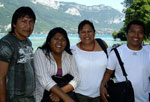Human Face of Human Rights
Going back to her roots - Gulnara Abbasova, a Crimean Tatar from Ukraine
 GENEVA, July 2007 - Gulnara Abbasova is a Crimean Tatar from Ukraine . Judging by her sidelong glance and cheerful nature, one could never tell she bears inside her the suffering of her people. Nor that this young lady of twenty-two has already set out her goals in life: ensuring the rights of indigenous peoples of Crimea are fulfilled.
GENEVA, July 2007 - Gulnara Abbasova is a Crimean Tatar from Ukraine . Judging by her sidelong glance and cheerful nature, one could never tell she bears inside her the suffering of her people. Nor that this young lady of twenty-two has already set out her goals in life: ensuring the rights of indigenous peoples of Crimea are fulfilled.
The Crimean Tatars are one of the indigenous peoples of the Crimea , a peninsula on the Black Sea , part of the territory of Ukraine . Crimea has close to 2 million inhabitants, most of whom are Russian settlers. Before it was annexed by the Russian empire in 1783, Crimea was a Khanate under Ottoman-Turk sovereignty. Crimean Tatars had immigrated massively, mainly to the Ottoman Empire , to flee Russian colonisation.
More ...
The Cry of the Forest - the indigenous Higaonon Community in the Philippines
 GENEVA, July 2007 - What's in a name? Arthuso Malo-ay has two names: the one on the passport that enabled him to travel to Geneva and the Office of the High Commissioner for Human Rights (OHCHR), and the one given to him by ancestral tradition. In his community, the Higaonons of the mountainous southern Philippines , Arthuso is known as Datu Pignanawan, meaning "leader of peace, and love and care for his community". It's a name that may point the way to Datu's destiny and the future of his people.
GENEVA, July 2007 - What's in a name? Arthuso Malo-ay has two names: the one on the passport that enabled him to travel to Geneva and the Office of the High Commissioner for Human Rights (OHCHR), and the one given to him by ancestral tradition. In his community, the Higaonons of the mountainous southern Philippines , Arthuso is known as Datu Pignanawan, meaning "leader of peace, and love and care for his community". It's a name that may point the way to Datu's destiny and the future of his people.
For centuries, the Higaonon people, or "forest dwellers", have been living in harmony with the once luxuriant flora and fauna of Mindanao . Theirs is one of the 118 ethnic groups that make up that small but densely populated archipelago. Today the 300,000 indigenous people of the Higaonon communities account for 0.35 per cent of the total population.
More ...
Climbing hills of injustice in North-WestCameroon - Rahamatu the Mbororo-Fulani
 GENEVA , July 2007 - Rahamatu Mallam Sali comes from a Mbororo-Fulani community in North-West Cameroon . Since their arrival from the Adamawa Plateau region in West-Central Africa at the end of the nineteenth century, these pastoralists have suffered considerable human rights violations. Rahamatu is part of a new generation of Mbororo-Fulani who want to bring about change in their community.
GENEVA , July 2007 - Rahamatu Mallam Sali comes from a Mbororo-Fulani community in North-West Cameroon . Since their arrival from the Adamawa Plateau region in West-Central Africa at the end of the nineteenth century, these pastoralists have suffered considerable human rights violations. Rahamatu is part of a new generation of Mbororo-Fulani who want to bring about change in their community.
In this Central African nation made up of 281 ethnic groups, only two tribes are recognized as indigenous: Rahamatu's tribe and the Mbaka Pygmies in the South. The Mbororo-Fulani represent an estimated 13 per cent of the general population with 2 million people dispersed on hilltops in remote areas of most of the country. This semi-nomadic people are becoming more and more sedentary, with a tendency to regroup into larger settlements.
More ...
A day in the lives of four indigenous leaders from Latin America
 The following stories are excerpts from the life experiences of four indigenous leaders who participated to the 2007 Spanish version of the OHCHR Indigenous Fellowship Programme. They wanted to share their story and a day of their lives just before they met: a day in the jungle, the mountains, the city and the desert. A day in which each of them devoted energy, passion and joy -the whole of their lives- to the protection of their rights.
The following stories are excerpts from the life experiences of four indigenous leaders who participated to the 2007 Spanish version of the OHCHR Indigenous Fellowship Programme. They wanted to share their story and a day of their lives just before they met: a day in the jungle, the mountains, the city and the desert. A day in which each of them devoted energy, passion and joy -the whole of their lives- to the protection of their rights.
More ...
See more stories